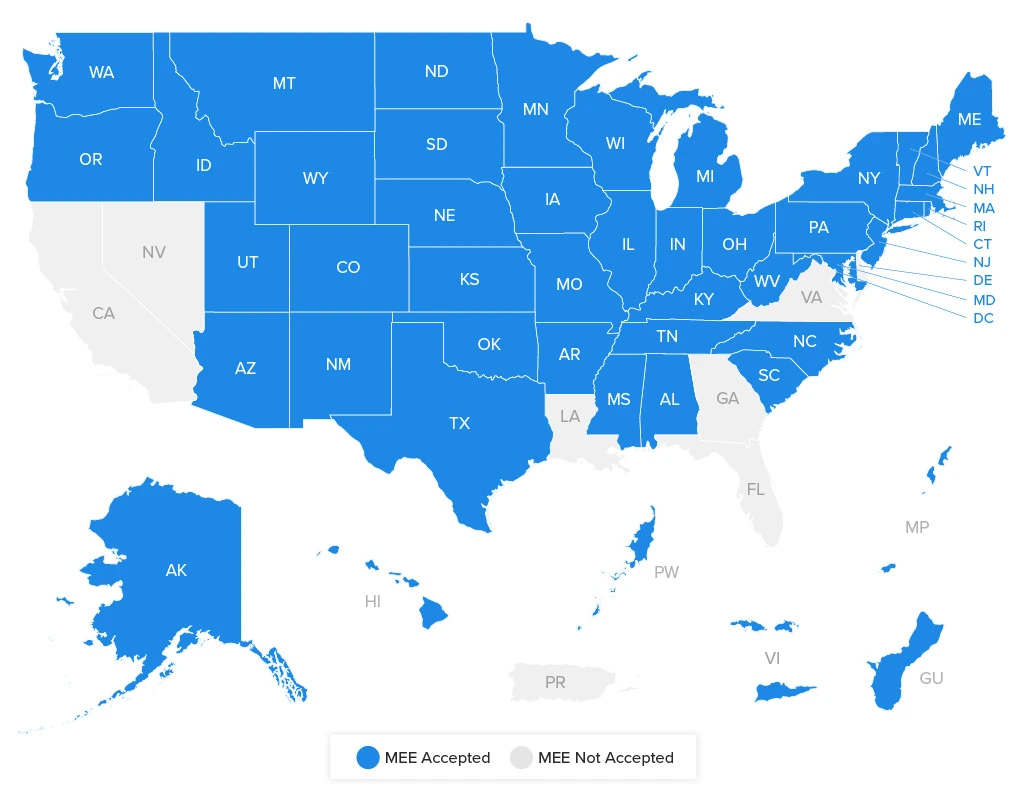MEE® Scoring
An Ultimate Guide to How MEE is Graded
The Multistate Essay Exam (MEE) is one of three components of the Uniform State Bar Exam (UBE®). An examinee's performance is presented as an MEE-scaled score via a statistical method called equating. The National Conference of Bar Examiners (NCBE®) develops all MEE questions from a pool of subjects that are uniformly administered across 41 participating UBE jurisdictions. MEE passing scores vary by jurisdiction. However, every UBE jurisdiction weighs the MEE component at 30%. In contrast, the Multistate Bar Exam (MBE®) and Multistate Performance Test (MPT®) are weighted at 50% and 20%, respectively.
The following article provides everything you need to know regarding MEE subjects, how it’s graded, how raw scores are converted into scaled scores, and more.
How is the MEE Graded?
The MEE consists of six essay questions. Each essay response is given a raw score ranging from 0 to 6. There is no passing or failing score for the responses. Your raw score for a certain response represents your performance in comparison to the other questions' examinees.
The 1-6 scale simply signifies that a score of 6 is reserved for the best essays among all responses given to a certain grader. It is better than a 5, which is better than a 4, and so on, all the way down to 1—a paper that is among the worst. Relative grading implies that even if no one paper addresses all of the arguments stated in an item, the strongest papers get a 6. (using a 1–6 score scale). They do not have to be flawless or deserve a genuine A or 100%. Using the same logic, a paper does not need to be utterly empty of substance to get a 1 if the other papers are good.
How Do Examiners Grade Your Essays?
The NCBE doesn't centrally grade the MEE or MPT. However, it does provide detailed grading materials and hands-on grader training to facilitate consistent and fair grading across all participating jurisdictions. This uniformity engenders score portability, thus streamlining score transfer.
MEE graders are typically practicing legal professionals (e.g., attorneys, judges) that have been provided with an instructional grading checklist. Examinees should make their essays legible and easy to read as graders are paid per essay graded, encouraging them to move quickly.
Graders are trained to identify consistent standards and grade essays by rank order. In other words, a score of 6 doesn't mean 100%. Instead, it indicates that an examinee's answer is among the strongest relative to its peers. Remember that this “1-6” score is your raw score, which will be converted into a scaled score.
MEE Raw Score to Scaled Score Conversion
Your raw score is not merely the sum of the scores from the six MEE responses and the two MPT questions. Rather, that computation is based on the weighting given by the UBE. MEE answers account for 60% of the written raw score, whereas MPT item replies account for 40%. The overall written raw score is then scaled to the MBE; a statistically accurate equivalent exam.
This scaling technique employs a statistical formula to translate the total written raw scores into the same standard deviation and mean as MBE scaled scores. This scaling method yields your overall scaled score on a 200-point scale, which accounts for changes in component difficulty between test administrations.
How do you calculate the MEE Score?
The MPT and MEE are worth 200 points in a Uniform Bar Exam jurisdiction. The MPT is worth 20% (or 80 points), whereas the MEE is worth 30% (or 120). If the MEE is worth 120 points, each MEE response will be scaled to be worth 20 points out of a possible 400 points.

Master frequently tested essay topics with our Essay Writing Skills Workshops.
A 4 out of 6 score is 13.33 out of 20
You would obtain an 80/120 if you scored 13.33 on each of the six MEE answers. A score of 80/120 equates to 66.67%, sufficient for jurisdictions that demand a score of 266. (It is slightly higher than passing if your jurisdiction needs a score lower than 266 and slightly lower than passing if your jurisdiction requires a score higher than 266.) If your jurisdiction demands a score of 280, you should strive for at least 14 on each MEE for a total score of 4.2. If your jurisdiction demands a 260, you may average 3.9 on each essay.
So essentially, anything between a 3.9 and a 4.2 is OK!
What is the MEE Passing Score and Average Score?
You may be wondering what average score you need on each MEE response to pass the MEE part of the bar exam. To pass the MEE in UBE jurisdictions, you must have an average score in the range of 3.9 to 4.2.
- For UBE jurisdictions that need a passing score of 260, an average score of 3.9 is sufficient.
- For UBE jurisdictions that need a passing score of 266, an average score of 4 out of 6 is considered passing.
- For UBE jurisdictions that need a passing score of 273, an average score of 4.1 out of 6 is considered passing.
- For UBE jurisdictions that need a passing score of 280, an average score of 4.2 out of 6 is considered passing.
Why is the MEE score important?
When studying for the bar exam, especially when preparing for the MEE, it can get difficult to judge and score your essays. And naturally, not knowing the rubric to fall back on for the MEE can get a bit confusing. Simply put, a Bar exam candidate has to write about six essays, and since it is the overall score that matters, there's always a winning chance.
Please note that just because MEE accounts for 30% of the UBE doesn't make it any less important. Firstly, all UBE-administered jurisdictions require applicants to sit for the MEE. During the MEE, candidates answer six 30-minute essay-type questions. The topics can range from identifying legal issues raised by a hypothetical factual situation to demonstrating an understanding of the fundamental legal principles.
To determine the jurisdictions that accept the MEE, please refer to the table below:
Secondly, the essays that the candidates are expected to write use the following legal analysis:
- Distinguish between relevant and irrelevant information.
- Offer an analysis of the issue in question with a clear, concise, and well-organized composition.
- Exhibit a solid understanding of fundamental legal concepts and principles.
For each element, the candidate must identify the associated legal issue. The difference between the MEE and the Multistate Bar Examination (MBE®) is that the former requires examinees to exhibit excellent written communication. Remember that the MEE is also one of the several factors that a board of bar examiners may use to determine your readiness to practice law. Each jurisdiction scores its MEE and adopts its policy about the MEE's relative weight compared to other scores.
How are the MEE scores released?
MEE scores aren't released as an independent score unless administered independently by a jurisdiction. Your scores will be available in the NCBE Account File Cabinet, and the test results will be stored in your NCBE Account until the next testing cycle. For instance, if you took the exam in February, you would not be able to see your score until the August test date.
Final Takeaway
Don't worry about how your work will be graded and scored. It would be best if you prioritized researching the legislation, doing practice essays to produce a high-quality response, and comparing those essays to the MEE analysis available for purchase by the NCBE.

Frequently Asked Questions
What is a good score on the MEE?
To pass the UBE in most jurisdictions, you’ll need an average score between 3.9 and 4.2. In states where a 260-point minimum is required, a passing grade is 3.9. In jurisdictions requiring an average passing score of 266, a 4 out of 6 is a passing score.
What is the grading scale range for the MEE?
The grading scale for MEE is between 0 and 6, with 0 being the lowest and 6 being the highest.
Is the MEE curved or scaled?
The MEE and MPT results are scaled to the MBE, and the NCBE calculates the overall UBE scores. The three sections of the UBE are weighted as follows: MBE is weighted 50%, the MEE is weighted 30%, and the MPT is weighted 20%.
Read More about the Bar Exam
Which state has the highest MBE scores in 2021? What pattern does the newly released MBE results show? Discover the numbers game of MBE 2021!
